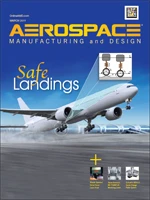 Mazak servo technology improves pierce time efficiency, especially in mild steel applications.REDUCE PIERCING TIME BY UP TO 80%
Mazak servo technology improves pierce time efficiency, especially in mild steel applications.REDUCE PIERCING TIME BY UP TO 80%
A servo head with piercing detection that monitors laser processing conditions and reduces piercing times, while improving cutting performance across a wide range of applications, is now a part of the Mazak Optonics product line. The servo head is provided as standard equipment on Mazak HyperGear, HyperTurbo, and SuperTurbo MkIII series laser-cutting machines. The Mazak servo technology improves pierce time efficiency, especially in mild steel applications between 0.375" and 0.750". It eliminates or greatly reduces the need for side blow during piercing operations. Sensors in the head monitor beam reflection to determine breakthrough, and then automatically signals the control to move to the cutting segment of the program. The machine quickly shifts from the pierce process to the start of cutting due to the auto-focus adjustment, which is on the dedicated W-axis. A typical nest cut time may be reduced by 30% by utilizing the new servo head and sensor technology. The same intelligent sensors monitor the beam for poor cut conditions and to maintain the cut. The servo head also improves overall edge quality when cutting mild steel plate of up to 1".
Mazak Optonics Corp.
Elgin, IL
mazaklaser.com
 Each of the spindles is served by a swivel unit, one of which acts with a barfeed mechanism.MILL/TURN CENTERS, SPINDLE VERSATILITY
Each of the spindles is served by a swivel unit, one of which acts with a barfeed mechanism.MILL/TURN CENTERS, SPINDLE VERSATILITY
The MC 726/MT-2C mill/turn, twin spindle machining centers are specifically design for the automotive, aerospace, tooling, medical, and other industries, where parts need to be milled and turned in production operations. The Stama MC 726/MT-2C machining center is the latest iteration of the popular Tandem concept mill/turn centers, introduced by Stama in 2007.
Two independent spindles are onboard, each on a traveling column assembly, and each supporting an independent swivel table, one of which acts with a barfeeder mechanism. Workpieces are introduced to the turning spindle, then transitioned by a conveyorized gripper assembly to the milling indexer, then fed to the milling spindle, before finally exiting the work area.
Complete 6-sided machining is possible between the two cutting operations, all on one machine with approximately twice the speed of a conventional mill/turn center while designed with a 30% smaller footprint. Since the first part is milled simultaneously to the next part being turned, the overall production operation is greatly enhanced, nearly doubling in many applications.
Stama America
Itasca, IL
stama-america.com
 The VERO-S quick-change pallet system is completely compatible and interchangeable with SCHUNK’s previous pallet system.QUICK-CHANGE PALLET SYSTEM
The VERO-S quick-change pallet system is completely compatible and interchangeable with SCHUNK’s previous pallet system.QUICK-CHANGE PALLET SYSTEM
All functional components of the VERO-S module are made of hardened stainless steel. Due to the dual clamping stroke and the integrated turbo function, the retention force has increased to 9,000 lb. The rigidity of the clamping system benefits from this higher force. As a result, considerably higher cutting forces are possible. Locking of the quick-change pallet system is done mechanically, by the use of a large spring package. It is self-locking; clamps with a form-fit; and has a holding force of up to 16,800 lb.
VERO-S clamps workpieces, pallets, clamping stations, existing fixtures, and tombstones with one or more clamping pins. The radial aligned clamping slides of the quick-change pallet system, pulls in the clamping pin and locks it; assuring a repeatability of less than 5μ (0.0002"). The VERO-S is completely compatible and interchangeable with SCHUNK’s previous pallet system, and the clamping pins work universally across the line.
Schunk Inc.
Morrisville, NC
schunk.com

Explore the March April 2011 Issue
Check out more from this issue and find your next story to read.
Latest from Aerospace Manufacturing and Design
- AAMI project call submission deadline extended to May 12
- Jergens launches cast iron tooling column additions
- Airbus to acquire assets relating to its aircraft production from Spirit AeroSystems
- FANUC America's Cobot and Go web tool
- Chicago Innovation Days 2025: Shaping the future of manufacturing
- High-density DC/DC converters for mission-critical applications
- #59 - Manufacturing Matters: Additive manufacturing trends, innovations
- ACE at 150: A legacy of innovation and industry leadership





